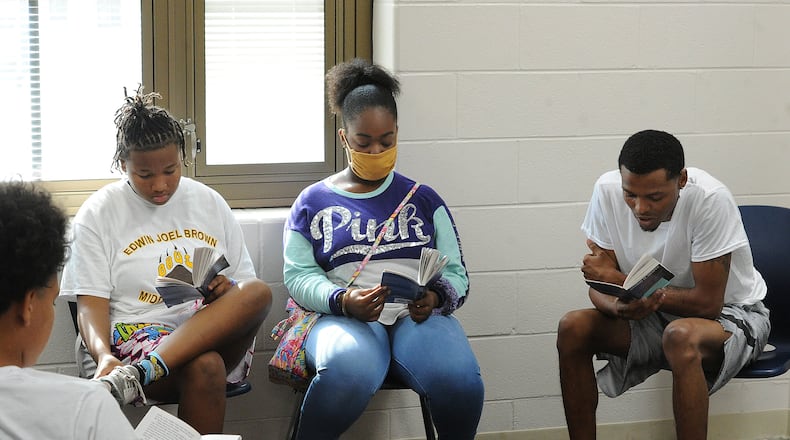Schools throughout the area implemented summer camps and more traditional summer school for those older students who didn’t pass their classes to help in the rebound from COVID-19 shutdowns and precautions that stunted academic growth.
In Huber Heights, for example, incoming eighth graders Honesty Booker and Variah Pauley attended STEM camp for two weeks in June. On July 1, they displayed their project — a carrier they made from a waffle cone box and other recycling materials — at a fair for parents and family members.
“I really didn’t want to come to camp because I thought it would be boring,” Booker said. “I’m mad today’s the last day.”
Huber Heights wasn’t the only school running summer camps for kids, trying to get them caught up in the face of learning loss. Dayton Public Schools also ran programs for elementary and middle school students.
Matt Housh, director of curriculum and instruction for Huber Heights schools, said the district recruited kids to summer camp based on academic need, but had additional spots. The district opened up the rest of the slots to other Huber Heights students and quickly filled all their slots.
“We feel like it’s super important to keep the learning happening over the summer,” Housh said.
It’s not clear how far behind middle school and high school students are statewide. But anecdotally, officials say high school and middle school students seem to have caught up faster than younger kids.
Shannon Cox, the Montgomery County Educational Service Center superintendent, said older students who had more experience with learning were able to come back from remote learning more easily.
But at the same time, the number of students who were chronically absent in Ohio jumped from 11% in 2019-20 to 24% in 2020-21. Chronically absent students are at a higher risk for dropping out than students who regularly attend school. They can also create gaps in their learning that need to be filled in the summer, which is where the summer programs come in.
Academic loss
Housh said much of the available remediation for high school students is focused on getting them caught up or getting them ahead.
“They’re able to more rapidly recover some credits so that they can either graduate or they can catch up,” he said.
Districts have been working on recovering learning loss all year, not just this summer. Dayton Public included a focus in secondary math in the recovery plan for this year. Elizabeth Lolli, DPS superintendent, highlighted the growth in Algebra, Geometry and Algebra II.
“We’re making some really, really significant progress there,” Lolli said. “Our teachers are focusing in and really pushing forward and doing a good job.”
Dayton and Centerville have been using internal testing to track their students’ growth, which both said has helped them keep tabs on the students.
“It’s an extra instrument for our staff to really work and dig in and see where those gaps were,” said Adam Ciarlariello, secondary curriculum director for Centerville schools. “I think that in some way, they’ve been able to be more prescriptive.”
More than academics
Middle and high school students have faced academic learning loss, but many have also faced social problems when they returned to school full-time last year.
Housh said Huber Heights staff have worked hard to build relationships with the students. Research has shown that kids who have stronger relationships with their teachers do better academically, he said.
“If a student is not feeling like school is something that’s important to me, or nobody cares about me, they’re not going to put in the effort and they’re not going to invest in themselves or academics,” Housh said.
Getting teachers to ask about a student’s parents or notice them in the classroom can make a huge difference, he said.
Administrators reported students had more behavioral problems, more mental health issues and an increase in vaping when they returned to school last year. Some of the students who had these behaviors aren’t the students districts would have considered “problems” pre-pandemic.
“Our children and our brains are meant to have very predictable and safe and structured behaviors,” Cox said. “They didn’t have that and it’s really thrown those middle school kids for a loop.”
There can be serious consequences for those kids, Cox noted, but the ESC is working with districts to keep students in classrooms when possible.
“We don’t want these children to be expelled from school, and then come back to school a year or two later, and then have a stigma attached to them,” Cox said. “We actually want them to be reunified with their community and build restorative practices so that they can be accepted back into their communities.”
Giving kids opportunities and consequences can help avoid long-term issues with the criminal justice system, she said.
Hope for this year
Cox said it’s also important for parents and teachers to set expectations for kids in a positive way. She suggested talking to kids about how they’re going to get back on track, she said.
“Kids ... they’re still going to be as smart as they’re meant to be,” Cox said. “They’re still going to go to college, they’re still going to go into the workforce.”
While there’s still a long way for kids to go, the district leaders said there has been a lot of growth, and they credit teachers.
“Now we just need to take that momentum that we have and continue to push forward to recover those individuals that still need some intervention,” Lolli said.
Ciarlariello said it helps to tell teachers that the work they’re doing matters.
“Our teachers work really hard and we need to celebrate where we can and remind them that what they’re doing, the work that the kids are doing, it’s meaningful,” he said.
About the Author





